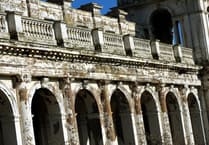More than 40 historic sites have been classed as ‘at risk’ across the South West following the release of Historic England’s 2023 Heritage at Risk list.
43 buildings across the South West have been identified as being at risk of neglect, decay or inappropriate development by Historic England.
The ‘Risk Register’ hopes to give an annual snapshot of the health of country’s valued historic buildings and places.
This year marks the 25th anniversary of the publication of the first national Heritage at Risk Register, previously known as the Buildings at Risk Register. Over the past 25 years, since it began in 1998, around 6,800 entries have been removed. This equates to around three-quarters of the entries that were on the original register. Many of the remaining entries from the 1998 Register have seen good progress despite often being the hardest cases to solve.
Among the list’s 4,871 entries, there are several familiar faces. Launceston’s Church of St Stephen is included, a report states: “Large urban parish church and the mother church for Launceston. Norman core with many additions finishing with the C16 tower. Restored 1883. Granite ashlar tower and outer walls to the west and south, the rest slatestone rubble with granite or greenstone dressings. The roof leaks and needs extensive renewal and repair. A Covid Recovery Grant has been given which has developed a repair program.”
Along with this report, the register notes that the building is in poor condition and is at “immediate risk of further rapid deterioration or loss of fabric”, although a solution has been agreed but not yet implemented.
As well as this, Launceston’s 13, High Street property has been highlighted as ‘at risk’.
The building’s report explains: “Jettied and timber-framed corner house, prominent on town’s market square. Roof structure and upper level party wall in poor condition. Vacant upper levels have deteriorated badly due to a lack of maintenance. Many repairs have been carried out to the roofs, gutters and slate hung walls. Structural and weatherproofing problems remain.”
However, unlike St Stephen’s Church, 13, High Street has been ranked as a top priority. As with no solution agreed, the building is at “immediate risk of further rapid deterioration or loss of fabric.”
Though it is not all bad news for South Western heritage sites, the launch of the most recent Risk Register has revealed some of the list’s removals, success stories which have been restored and repaired. One of these is in Newport in Launceston, the packhorse bridge.
This five-arched packhorse bridge is believed to have been built in the 15th century to serve the nearby priory of Launceston. Carrying only foot traffic, it is a rare example of a monument that has survived almost unchanged. The bridge is used daily by the local community and the wide shallow river makes it a favourite place for local people to come to sit and rest and feed the ducks.
However, during the COVID-19 lockdowns the bridge suffered increased vandalism. In addition, a nearby footbridge over the River Kensey was closed for rebuilding and foot traffic was re-directed over the packhorse bridge. A number of the large slates capping the edge of the bridge were dislodged and knocked into the river or stolen. Cobbles from the footway went missing, and the bridge became overgrown in places, as such, the bridge was added to the register in 2021.
During 2022, all these problems were addressed with a programme of sympathetic repair works carried out by Cormac Solutions for Cornwall Council.
Andrew Smith, Project Manager at Cormac, said: “We are really proud to have restored one of Cornwall’s historic structures. The packhorse bridge plays an important role in the community here in Launceston. It’s a lovely example of a bridge of its kind, and great sensitivity and expertise has been used in safeguarding it for the future.”
Rebecca Barrett, South West Regional Director at Historic England, added: “Looking after and celebrating our heritage is so important. With the publication of the Heritage at Risk Register each year, I’m always inspired by the stories of communities coming together to help save historic buildings and places and to find new uses for them.”




